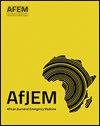The evolving role of paramedicine educators: A scoping review
IF 1.2
4区 医学
Q3 EMERGENCY MEDICINE
引用次数: 0
Abstract
Introduction
Growing responsibility and changes to paramedicine and prehospital care have led to rapid developments in paramedicine education. Despite educational requirements at increasingly advanced levels, it remains unclear how academia has responded to these changes and if they're developing the requisite skills and knowledge.
Methods
A scoping review was undertaken to understand the present role of paramedicine educators and how they've adapted to the evolution of paramedicine education worldwide. Data searches were performed across eight electronic databases, six paramedicine journals, grey literature, and included sources reference lists.
Results
The four-staged search strategy revealed 1,738 sources, of which 32 remained for final synthesis. In general, there was a lack of contemporary research examining the role of the paramedicine educator despite changes to Higher Education provision and function of paramedics. Noteworthy was the absence of articles from Africa, South America, and major parts of Europe, highlighting the need for development in these regions. There is a lack of clear role descriptions or definitions for paramedicine educators. Inconsistencies were highlighted in entry criteria and progression routes across paramedicine academia globally, emphasising the importance of support for transitioning and established paramedicine educators.
Discussion
These findings have important implications for Higher Education. Professional demands are on the rise, creating a need to introduce clearly defined roles for paramedicine educators to provide clarity in expectations and increase confidence. The changing landscape of care provision in paramedicine from the historic emergency care focussed model to a more autonomous and inclusive sphere of out-of-hospital care, provides an ideal opportunity to progress and shape the identity of the paramedicine educator.
辅助医学教育者角色的演变:范围综述
护理医学和院前护理的责任和变化导致了护理医学教育的快速发展。尽管高等教育对教育的要求越来越高,但学术界如何应对这些变化,以及他们是否在培养必要的技能和知识,目前还不清楚。方法进行范围综述,了解当前辅助医学教育者的角色,以及他们如何适应全球辅助医学教育的发展。数据检索在8个电子数据库、6个辅助医学期刊、灰色文献和包括的来源参考列表中进行。结果四阶段搜索策略共发现1738个源,其中32个源待最终合成。总的来说,尽管高等教育的提供和护理人员的功能发生了变化,但缺乏当代研究来检查护理医学教育者的作用。值得注意的是,没有来自非洲、南美洲和欧洲主要地区的文章,强调了这些地区发展的必要性。辅助医学教育工作者缺乏明确的角色描述或定义。强调了全球辅助医学学术界在入职标准和晋升途径方面的不一致性,强调了支持过渡和建立辅助医学教育工作者的重要性。这些发现对高等教育具有重要意义。专业需求正在上升,因此需要为辅助医学教育者引入明确定义的角色,以提供清晰的期望并增加信心。从历史上以紧急护理为重点的模式到更加自主和包容的院外护理领域,护理提供的变化景观为护理教育者的进步和塑造身份提供了理想的机会。
本文章由计算机程序翻译,如有差异,请以英文原文为准。
求助全文
约1分钟内获得全文
求助全文
来源期刊

African Journal of Emergency Medicine
EMERGENCY MEDICINE-
CiteScore
2.40
自引率
7.70%
发文量
78
审稿时长
85 days
 求助内容:
求助内容: 应助结果提醒方式:
应助结果提醒方式:


